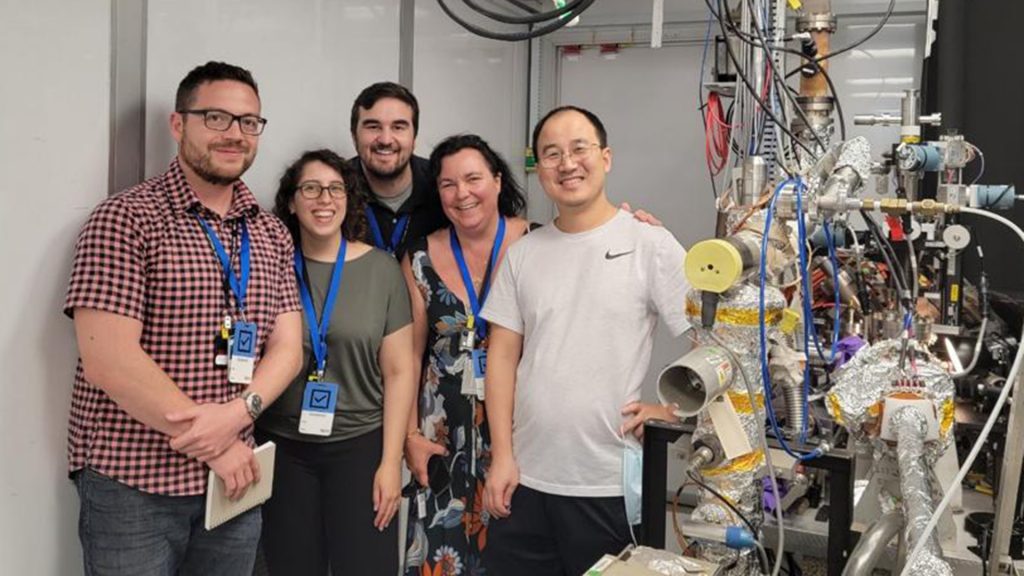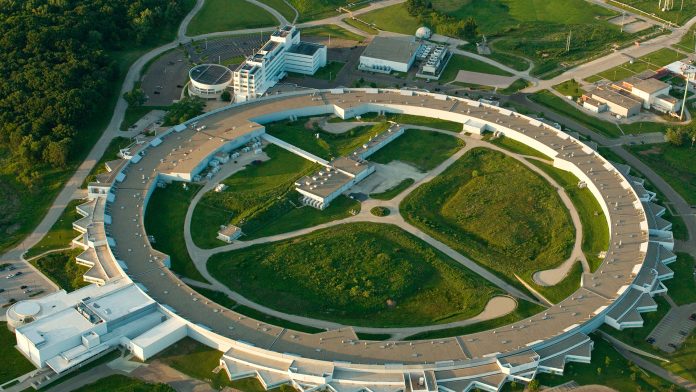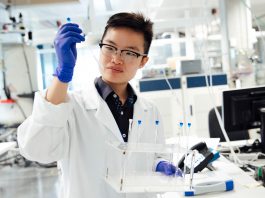Dr Sandra Biedron, a Research Professor at the University of New Mexico and former Argonne physicist, spoke to The Innovation Platform’s Georgie Whitworth to discuss particle accelerators as research infrastructures and their crucial role in discovery.
The immense value and capability of particle accelerators, and the research infrastructures behind them, have never been more evident than today. Whilst the applications for such accelerators are hugely varied, the COVID-19 pandemic has highlighted their use as a key tool in the medical field. For example, the Advanced Photon Source (APS) at Argonne National Laboratory has allowed for the analysis of SARS-CoV-2 S protein to enhance understanding of the COVID-19 virus.
The Advanced Photon Source, first operational in 1995, has been used in a broad spectrum of disciplines, from materials science and physics through to biological science. The APS was developed by a dedicated team of scientists and engineers with a whole host of varied specialisms.
One team member involved in the development of the APS, who has been recognised on several occasions for her notable achievements in the world of particle accelerators, is Dr Sandra Biedron. Born and raised in Chicago, where several key US scientific infrastructures reside*, Dr Biedron has had a long and fruitful career as a physicist. From 1993 to 2011, she worked at Argonne National Laboratory and, from 2005 to 2011, was an Associate Director of the Argonne Accelerator Institute and a Senior Physicist and Director of the Department of Defense Project Office. Dr Biedron left Argonne in 2011 and now works as a Research Professor in Electrical and Computer Engineering and Mechanical Engineering at the University of New Mexico. She is also a managerial member of technological company Element Aero.
The Innovation Platform spoke to Dr Biedron to find out more about her current research and what continues to excite her about particle accelerators as research infrastructures.
What are the key objectives of your current particle accelerator research?
I have many research passions, but I will focus on my favourite for now: particle accelerators. There are so many facets to this focus. Aside from the numerous areas of research, there are design and simulation challenges due to complicated multi-physics phenomena. With these phenomena, there are limits to how we can produce, control, and use the beams. The field crosses many disciplines, including physics, chemistry, vacuum science, controls, magnet engineering, radio frequency engineering, materials science, etc. Ultimately, all these pieces fit into one system. It is really a human choice to divide up the disciplines, as nature otherwise does not. Even with large machines like particle accelerators, all systems work together – there is a delicate balance and synergy.
I will now share examples of recent research and development that leverage a variety of research infrastructures. There are five unique genres of machines for the five following applications: x-ray free-electron lasers (FELs), electron diffraction, particle physics, radiation testing, and quantum information science.
I am particularly interested in the operation of the particle accelerator and the ‘user side’ of the machine as one entire system. This is one of our key focuses today. We are trying to operate a MeV Ultrafast Electron Diffraction (MUED) facility globally. We would like to eventually fully automate the system – from automatic turn-on, tune-up and operation – that would require little or no human intervention other than to prepare and change the materials samples.
This MUED system is a DOE Office of Science’s User Facility – the Accelerator Test Facility (ATF) at Brookhaven National Laboratory. It does not stop there, however, as we want to understand the diffraction patterns in real-time alongside trying to interpret their structure. To do so, we must use techniques involving Artificial Intelligence (AI) and Machine Learning (ML), enabled by computational resources such as coupling to a second research infrastructure – the Argonne Leadership Computing Facility (ALCF) at Argonne National Laboratory. Academics at Brookhaven, including Mark Palmer, Marcus Babzien, Bob Malone, Mikhail Fedurin, Junjie Li, and professionals at Argonne such as Mike Papka, David Martin, and Thomas Uram, at these user facilities make this possible. We seamlessly blend many people together and even my own team is made up of a collective of experts. Mariana Fazio contributes materials expertise, Salvador Sosa provides specialist input on accelerators, and Manel Martinez-Ramon is an expert in AI and ML. We also have great materials experts as collaborators at LANL, such as Alan Hurd, and AI/ML expertise from Christine Sweeney.

To tune up a similar device at the ATF, we are working on a similar approach to tuning a portion of the system in a funded collaboration with the Cornell-led Center for Bright Beams (CBB), led by its Director, Professor J Ritchie Patterson. My UNM graduate student Aasma Aslam is collaborating with Marcus Babzien of BNL on this project. I am also part of this project and serve as faculty for CBB. Improvements on the electron source in this other portion of the ATF user predictive laser control employ several specialised optics, including a spatial light modulator which will be insertable into this and other MUED systems. In summary, it takes many talented individuals, with a combination of specialisms, to find solutions to complicated problems on complex, nonlinear systems.
At the SLAC National Accelerator Laboratory, we are working on something similar but confined to one system – using techniques including AI/ML to enable better control of the low-level radio-frequency (LLRF) system at their upcoming research infrastructure – the Linac Coherent Light Source II. Alessandro Ratti and Andy Benwell host my PhD student Jorge Alberto Diaz Cruz for this collaborative activity. Again, much like the MUED-based system, we leverage a second research infrastructure – the ALCF – for this research as well.
How are you supporting research at the Los Alamos Neutron Science Center?
In addition, we support a DOE National Nuclear Security Administration (NNSA) research infrastructure – the Los Alamos Neutron Science Center (LANSCE)-driven Coherent CAPTAIN-Mills (CCM) experiment at the Lujan Center at Los Alamos National Laboratory (LANL) that makes use of the intense proton flux and the CCM detector to determine if new Beyond Standard Model (BSM) particles are at the heart of the combined several anomalies seen in previous experiments at LANL and Fermilab.
LANSCE’s high-power, 800-MeV proton beam provides a unique opportunity to explore whether new BSM particles, such as axions, light dark matter, or sterile neutrinos, exist in nature. The results will have a profound impact on our understanding of particle physics and may have deep implications for cosmology.
We are searching for BSM physics that may indicate possible connections to the dark sector (i.e., the dynamical sector associated with dark matter in the Universe). My student, T J Schaub, and several others in my group, including Fazio and Sosa and I, are part of this large CCM collaboration led by LANL’s Richard Van de Water. Such collaborators at LANL are key to establishing the synergies with my group. This also plays into the systems approach of optimising the accelerator performance output application. Not only do we focus on the particle physics experiments, but also on making shorter, more intense proton pulses to enhance the signal for several genres of experiments at Lujan, as outlined in a whitepaper for Snowmass.
CCM just had two of its papers accepted: First leptophobic dark matter search from the Coherent–CAPTAIN-Mills liquid argon detector in Physical Review Letters and First dark matter search results from Coherent CAPTAIN-Mills in Physical Review D.
What are some of the challenges of access to particle accelerator ion facilities?
A well-known problem for the radiation effects of, for instance, the aerospace community, is the lack of access to ion facilities and an overall lack of availability, as there is a very small number of ion and other radiation facilities. In a recent report, it is stated that there is a gap of 5,000 hours per year at ion facilities. From our discussions with many organisations, we have found that these numbers tend to be much higher. One organisation said that they need well over 5,000 hours for their own testing alone. An academic said they would take any ion they could get as they are that desperate. I do not wish to restate in great detail this overarching challenge, but only note that the machines, such as Van de Graffs and cyclotrons, that were developed/enhanced for such applications as those in the Manhattan project 80 years ago have been optimised to their technological limit. We are also working on ways to make such ion sources more readily available, including using advanced accelerator concepts using lasers. We are leveraging several research infrastructures for this work, including the ALCF for the intensive multi-physics simulations.
How are quantum information science systems (QISS) used as particle accelerator research?
As we have all heard, quantum information science systems (QISS) promise to revolutionise our present communication and computational paradigms. This has prompted a race between countries and institutions alike towards building practical QISS. For example, in 2018 the US launched a national initiative on developing technologies that will help enable practical QISS. The technological leap enabled by QISS comes from harnessing the quantum properties of atomic, electronic, and photonic systems to perform calculations that are virtually impossible even with state-of-the-art classical computational systems. Whilst there are several approaches to practical and scaleable QISS, ours builds on trapped ion systems and offers a solution to scaling limitations found in conventional ion traps, even at the state-of-art level.
We are exploring a miniature storage ion ring as a possible solution. A circular radiofrequency cavity (CRFQ), for instance, is an extension of a quadrupole ion trap. Such a device is simply an unbounded version of a quadrupole ion trap, which is a linear device. In our device, we employ a special state of matter, cooled ion Coulomb crystals (ICCs). This storage-ring quantum computer is still in the design stage, in which we again leverage computing resources, including the ALCF and several local clusters. This device relies heavily on Machine Learning techniques. Specifically, we require a ‘digital twin’ to help us determine, for example, the location of ICCs during operation of QISS. This work is done in collaboration with members of my teams including Trudy Bolin, Aasma Aslam, Salvador Sosa, as well as individuals from Brookhaven Laboratory (Kevin Brown), Stony Brook University (Bohong Huang), and the University of Southern California (Clio Gonzalez- Zacarias). Some of the research is reflected in a recent paper published in IEEE Access in February 2022.
These are just some of the many applications for accelerators. There are more than 30,000 particle accelerators worldwide for applications ranging from discovery science, security and defence, energy and the environment, medical, industrial, and even archeology and anthropology, and many more. I would like to mention my colleague and friend, Vito Mocella in Naples, Italy, who uses the European Synchrotron Radiation Facility (ESRF) to determine the hidden letters in rolled charged Herculaneum papyri. In addition, another colleague and friend, Mitsuru Uesaka based in Tokyo, Japan, uses compact accelerators for testing bridges for safety as well as for environmental measurements to help with remediation methods.
*Note: Argonne National Laboratory and Fermi National Accelerator Laboratory are both located in the greater Chicago area and both have many research infrastructures and other equipment and facility resources for the research community. Many of the access is peer-review driven but there are also other methods to collaborate, including modest cost per hour for some facilities and in-kind considerations.
Sandra Biedron
Research Professor
University of New Mexico
biedron@unm.edu
www.unm.edu
Please note that this is an excerpt of an article which appears in the tenth edition of our quarterly publication





